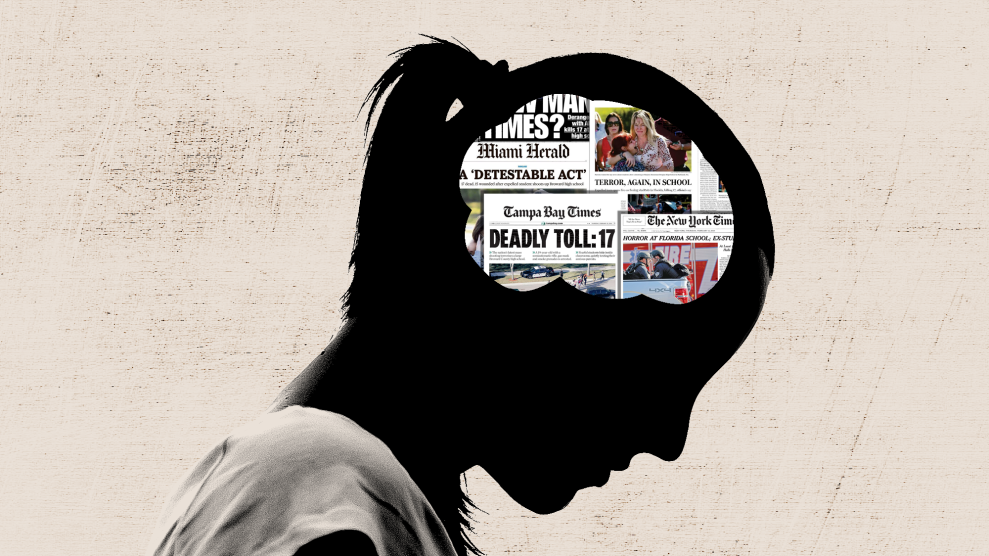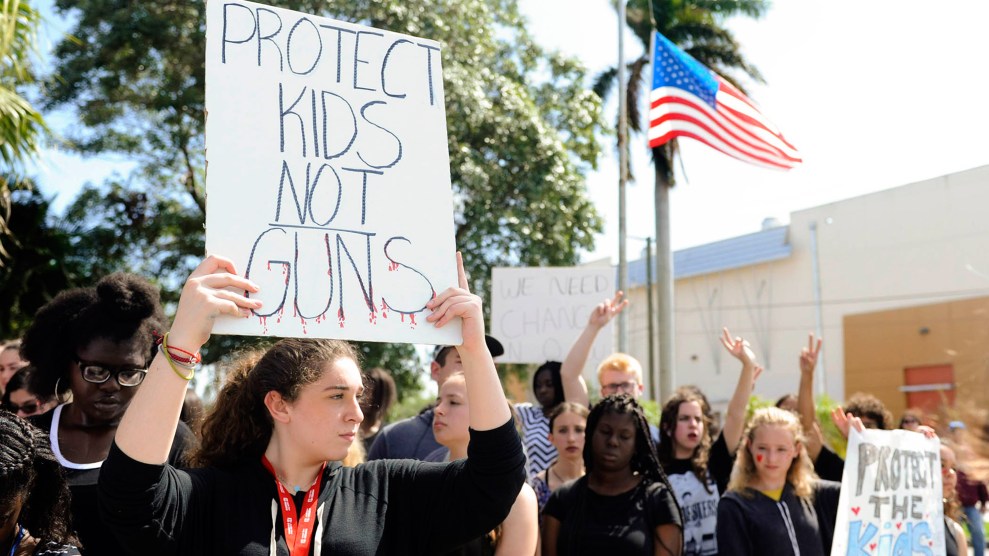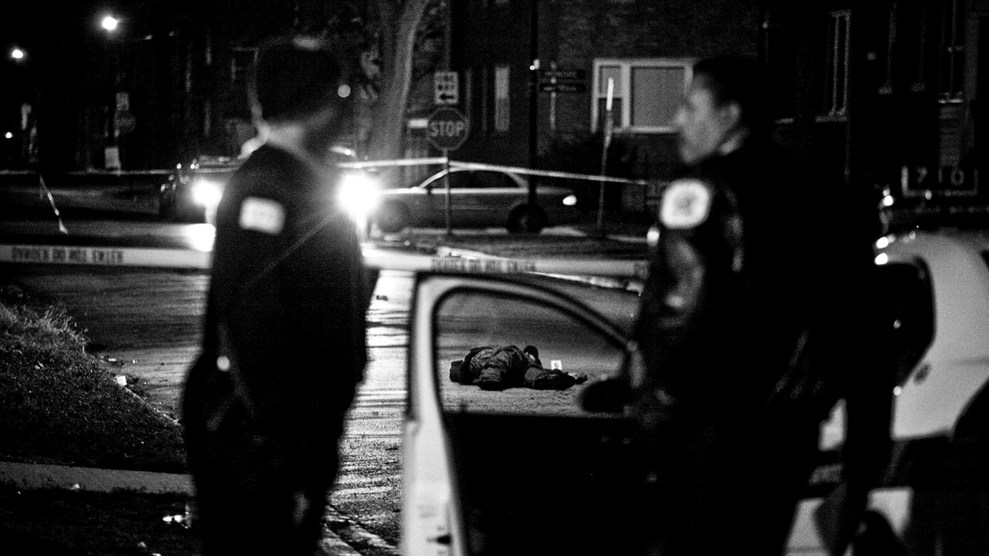
Mother Jones illustration; kieferpix/Getty
This article first appeared on TomDispatch.com.
“It was no surprise to anyone who knew him to hear that he was the shooter.”
—Emma Gonzalez, Senior, Marjory Stoneman Douglas High School
Over the past three weeks, the impassioned voices and steadfast demands of the students of Marjory Stoneman Douglas High School have resounded across social media and through the halls of the large suburban high school where I teach visual arts. A group of senior girls, spurred to action by the horrors of the Parkland massacre and emboldened by watching videos of its protesting students, organized a walkout of their own. Though it was an uncharacteristically cold, snowy day in our part of Oregon, hundreds of students marched out of school, engaging in what was certainly, for many of them, their first act of civil disobedience. I positioned myself near the back of the crowd, listening as they shouted their demands for safer schools and an end to fear in the classroom. Standing on that icy sidewalk, I was overcome by waves of conflicting emotions. Though deeply proud of them for raising their voices and insisting on being heard, I was also forced to confront a stark and brutal reality: Neither my students nor I feel safe in our school.
I still remember the cold December morning in 2012 when I first heard about the massacre at Sandy Hook Elementary School in Newtown, Connecticut. A colleague walked up to my desk, tears streaming down her face. She then recounted the grisly details of those shootings: a classroom of first graders and their teachers murdered on what should have been just another routine school day.
At the time, my daughter was a preschooler. In those school pictures that began appearing in the media of gap-toothed Sandy Hook first graders I saw her face. I began to think about her future in such a world and it looked bleak. From that moment on, I couldn’t bear reading the stories of what had transpired within those school walls and so found myself avoiding the impassioned, anguished speeches of the brave parents and teachers of those senselessly slaughtered children. It hit too close to home. It was horror on a level I had previously thought unimaginable and in a school not that different from mine. Naively, I assumed things would have to change, that nobody could look at those tiny little people and callously advocate for the status quo. How wrong I was. And as we all know, the shootings just kept happening.
So what was it about the Parkland killings that tipped the scale? Why hadn’t this happened after Columbine or Newtown? These are among the questions we teachers have been asking one another at my school recently. Perhaps what’s driving this moment is fear of the seeming inevitability, the not-if-but-when of it all. As teachers, we are forced to wonder: When will it be our turn? When will we bar the doors, fight, run, or hide? When will despair be given a physical form in the shape of a teenager with a gun and our school turned into a shooting gallery for the deranged?
At this point, we’ve been practicing lockdown drills for years. We lock and block the doors, then huddle on the floor in the darkest corners of our classroom—36 teenagers and one adult trying to be as quiet as possible. No phones, no talking, no movement. We wait for the rattle of the door handle, at least one of us cries, and then it’s over. The all-clear.
We turn on the lights, stretch our cramped limbs, and return to our seats. I tell a joke, try to lighten the mood a bit, and resume class. One grim effect of these drills and procedures, though, is to normalize the threat of an act so heinous, so abnormal, it’s hard to take in. We’ve essentially desensitized our entire school community to the true horror of what we’re playing out—fight for our lives. We expect the routines of the classroom to resume once the lights come back on, hoping that the students will have grasped the seriousness of the drill but won’t have internalized the fear. That none of us will. When my students voice the fear that sits inside them in that darkened room, when they give the despair space to breathe in the light, we’re all forced to confront the twisted reality of what we’re doing.
At the beginning of the semester, I gave my new students a questionnaire about their lives. One of them answered the question, “What is one thing that really stresses you out?” by writing: “What really stresses me out is the fact that I might die in this building.”
I had no idea how to respond because, honestly, I feel the same way. How do I convey what it feels like to walk into your workplace every morning wondering if today is the day you’ll die there? How do I explain the trepidation I feel when I have to confront that student—the one who’s been making the disturbing art, doesn’t smile or interact with his peers, and whose parents won’t return my emails or calls—to tell him that he needs to tone down the violence in his work? How do I share my deepest fear that this is the kid who will come back for me later, armed and ready to exact his revenge?
How do I express the complexity of the emotions I feel when I’m huddling in the dark with my students, thinking about what it would take for all of us to make it out of the building alive in a real version of the same situation? And how do I begin to think about the worst possible scenario, that the 16-year-old kid crouched next to me in the dark is the next school shooter? In the heightened paranoia of my classroom, my students are now suspects.
I imagine every new teacher arrives with some version of the story of the triumphant teacher who takes a ragtag group of students from disarray to academic excellence playing in the back of his or her mind. That cinematic dreamscape is often discarded as the years go by. If you’re actually going to survive in the system, tough it out for the long haul, certain illusions must be shed. Almost a third of all new teachers jump ship by year three when the challenges of the profession—the long hours, the constant planning, the never-ending grading, and the worries about meeting the intellectual and emotional needs of our students—begin to seem unsustainable.
In my first years on the job, the enormity of the psychological task of caring for the wellbeing of my students and a creeping awareness that I would never be able to fully support and know all of them could reduce me to tears. My commute home in the afternoon often felt like a therapy session sans therapist. I’d replay every missed opportunity, every interpersonal challenge, and then I’d cry. I knew that, despite what I’d been led to believe, the stark reality of the situation was that I couldn’t support all of my students. Part of teaching would always be about failure: failure to connect, failure to notice, failure to address the nuanced and specific needs of every one of those students. It was a numbers game that I would always lose and that was a truth I had to embrace in order to become a more effective educator.
Nevertheless, the archetype of the teacher-martyr who toils late into the night, sacrificing her personal life in order to focus solely on her students, is one we’ve bought into as a culture. The story we tell is that teachers are superhuman, capable of reversing any tide, remedying any hurt, and counteracting the problems of our society by sheer focus, persistence, and care. If I just devote myself more, put in longer hours, and implement a better curriculum, I’ll ultimately save them all. Being this martyr is a badge of honor in the school itself, a symbol of who is doing the best work. I can’t help but wonder, though: Isn’t martyring oneself by taking a bullet for our students the ultimate expression of this archetype? Isn’t this what is, post-Parkland, now being demanded of us?
This uniquely American myth of the teacher who provides salvation for each student is the one we’ve now ascribed to the teachers at Parkland who threw their bodies in front of bullets to save their students’ lives. And while I’m awed by their bravery, I’m still willing to question the motivations of those, including the president of the United States, who hold them up as icons.
Perhaps valorizing teachers as heroes is simply another way of continually refusing to honor and respect the profession in the ways that actually matter. Heroes don’t need smaller class sizes, benefits or adequate retirement accounts. The truth is, those teachers should never have had to put their lives on the line for their students. It wasn’t their job. We are not warriors, we are teachers. We are not heroes, we are teachers.
My last year of classroom teaching has been the most demanding. Not only because of the subjects I teach, my class sizes, or workload, but because of the mounting stress I feel from my students. Our children are the canaries in our American coal mine—an image that has new meaning in the Trump era. When I ask them about their mental health, I’m always overwhelmed by how many of them admit to depression and anxiety. They’re constantly exhausted and stressed out. So many of them express a simmering despair about their future. And how can I argue with that? When you’re huddled in the corner of a dark classroom, practicing for your own death, it’s difficult to feel as if there’s any hope for a decent future.
I’m no longer naïvely dreaming of changing the lives of each of my students. My goals have narrowed: to get the kids to invest in learning, to be an advocate for them, to listen to them, to create a relevant curriculum, to turn the classroom into a vital and thriving place. In any given semester, I make it a priority to quickly learn the names of my more than 200 students, to check in with them as frequently as I can and attempt to attend to each of their unique and complex individual needs.
I try to put whatever extra energy and attention I have into working with my more marginalized students, knowing that, as a white, middle-class woman, they likely will see me as an agent of a system that reinforces preexisting layers of alienation. However, I no longer feel as if I can save any of them. I don’t even feel that that’s my job. My job is to provide a space for inquiry and expression.
If I do that job well, I’ll at least assist my students in finding their own voices. But believe me, it’s a Sisyphean task. They’re teenagers after all. Their emotional landscapes change minute by minute, day by day. They walk into my classroom with 15 to 18 years of lived experience, products of their family dynamics and their community. The hours I spend with them, no matter how impactful, cannot out-compete those actualities. Some of them will feel seen and heard in my classroom, and some of them, no matter what I do, will feel invisible, unseen, and lost.
School is the place where adolescents experiment with the lofty promises of the American Dream. We teachers deliver the message that you can be anything, do anything. Study hard enough and you’ll make something of yourself in your life, no matter the challenges along the way. Make friends, get yourself a boyfriend or a girlfriend, and you’ll climb that social ladder. Find your path and your talent and the world will be yours for the taking.
As educators we know that there’s no one more passionate and engaged than a teenager doing what she or he loves. Tap into that intensity and myopic focus and you have the potential for genuine pedagogical alchemy. But what if all the promises that we (and so many others) implicitly or explicitly make prove remarkably out of reach and those same students are increasingly aware of that? What if you’re a student of color or an undocumented student and the American Dream was never promised to you in the first place? What if you don’t make friends easily? What if the emotional stresses you carry with you are too heavy and all school represents is a relentless reminder of them? What if, like the society it’s part of, school becomes a place for failure, not possibility?
If teenagers excel at one thing, it’s sniffing out hypocrisy. Kids can see through the veneers of so many promises. And the kids any teacher now sees are likely to be wondering: What’s really there for them in this world we’ve built? What hurts have gone unnoticed, unattended?
Is it any wonder that the most disgruntled among them, those who feel most betrayed by the broken promise of that dream, return to the place they feel failed them the most, the institution society promised would provide them with salvation and so obviously didn’t? They bring with them their failed social and familial relationships, their realization that the dream was never for them in the first place, and, in a rising number of cases, AR-15s or other deadly weaponry. They cash that voided check by pulling the trigger, decimating that illusion, and possibly ending the lives of students and teachers while they’re at it.
Shooting that gun is the last act of personal agency these boys—and so far they are all boys—have to offer. That myopia and total focus, which leads to death in our schools, reflects the despair and nihilism seen in many of these shooters. It’s something that, at least at a lesser level, should be familiar to any classroom teacher these days. Think of the nameless, faceless frustration and despair that drives a child to pick up weapons of war and wantonly kill as the failure of the American Dream played out in blood.
Dear America: You’ve given me an impossible task and condemned me for my failure to perform it. Now, you—or at least the president, the NRA, and various politicians—assure me that I can redeem myself by holding a gun, firing back, and so blasting away the despair. No, thank you: I do not want to hold that gun and cannot be that shield. Neither figuratively nor physically can I save my students.
What we are asking of our children, our teachers, and our schools is unlike anything we ask of any individuals or any institution. We are martyring our children on the altar of society’s failed promises and then we wonder why they keep coming back with guns in their hands.
Belle Chesler teaches visual arts at a high school in Beaverton, Oregon.
















